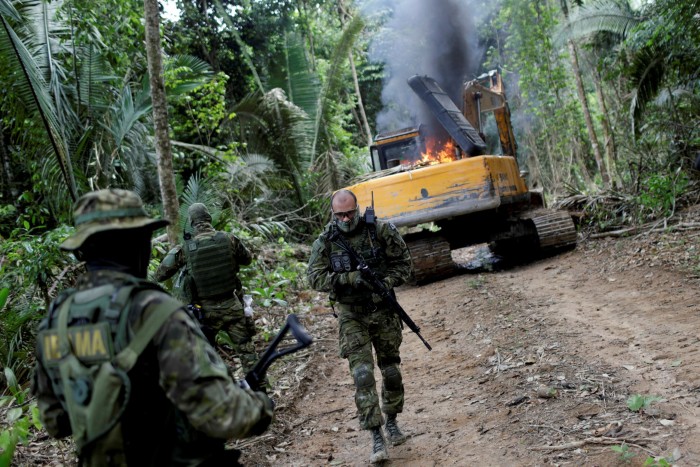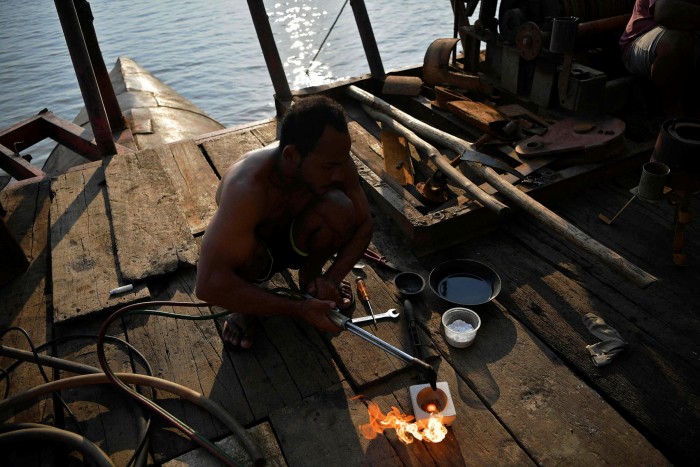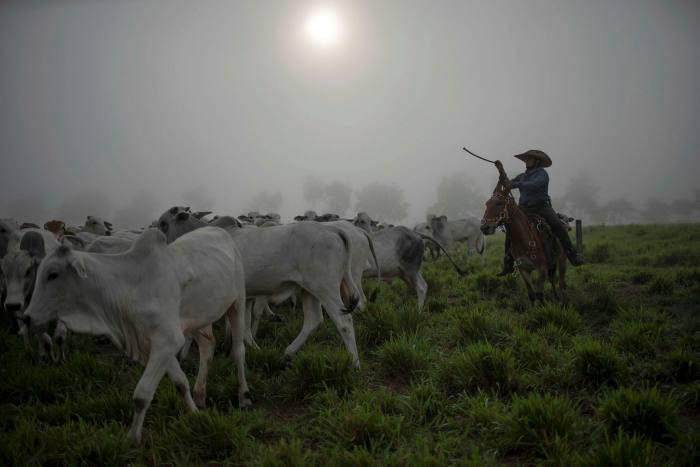Policing the Amazon: on the front lines of deforestation

The battle of Jacareacanga began with a bonfire. Acting on court orders to protect indigenous land, Brazilian federal police swooped on a vast illegal gold mine deep in the Amazon rainforest, setting fire to 18 pieces of heavy construction and digging equipment.
Infuriated, the miners mobilised in their hundreds in nearby Jacareacanga, a remote town on the banks of the Tapajós river. Coordinating via WhatsApp, they tried to storm the nearby airstrip and, according to police, set fire to the helicopters that authorities were using to locate the mines. Later they torched the home of a local indigenous activist.
“These are people who never felt the power of the state, only the lack of the state. They settle their issues with little wars,” says Gustavo Geiser, a police officer involved in the operation in May.
The stand-off ended after the federal police — Brazil’s equivalent of the FBI — launched tear gas and rubber bullets against the throng. The vice-mayor of Jacareacanga was later arrested for his alleged involvement in the conflict.
The clash was just one in a litany of incidents that illustrate the dangers facing those who seek to protect the Amazon. Far removed from the world’s attention — and the high-minded rhetoric of politicians and companies at the COP26 conference in Glasgow — it is Brazil’s environmental enforcers on the front lines in the fight against deforestation and the myriad criminal networks that permeate the rainforest. And these “forest defenders” are increasingly isolated, underfunded and under attack.
Since the inauguration of far-right President Jair Bolsonaro in 2019, the two environmental agencies that Brazil has long relied upon to monitor and protect the rainforest — Ibama and ICMBio — have had their enforcement budgets slashed. Ibama currently has less than 600 field agents to monitor the entirety of Brazil — down from 1,300 a decade ago — although facing international pressure the government recently announced plans to increase this force.
These complaints did not start with the Bolsonaro administration. For years, hiring was frozen. But increasingly the organisations are being stacked with appointees who are either loyal to the president’s wishes to open the rainforest for business or lacking in experience in protecting the biome from its various threats, which include illegal mining, logging, cattle ranching and land grabbing as well as the pervasive violence that accompanies each.
Despite the pledges to end illegal deforestation by 2030 at the COP summit last week, those working on the ground in the Amazon say they no longer feel like they have institutional support for operations that often challenge powerful — and political — interests in a region almost as large as the continental US.
At the same time, there is broad agreement that the groups destroying the forest have become emboldened since the rise of Bolsonaro, who regularly expresses sympathy with the likes of the gold miners — known locally as garimpeiros. These illegal groups do not feel threatened by prosecution, environmentalists and police say. What is more they believe the current government might even legalise their activities or contentious claims to Amazonian lands.
“From 2019 onwards there has been an increase in violence, death threats and intimidation. This is because the Brazilian government has given carte blanche to those committing crimes in the Amazon to continue doing so,” says Gilson Rego of the Pastoral Land Commission, a Catholic church-backed land rights group, which has recorded hundreds of murders resulting from Amazon land disputes in recent years.
“All the illegal actors feel comfortable committing violence, murdering if necessary, because they will not be punished,” he says, pointing out that only a small fraction of these homicide cases end in successful prosecution.
This renewed confidence among the region’s criminal groups has spurred a surge in deforestation that in the past two years has garnered global attention and cast Brazil as an environmental pariah.
Aware of the importance of the Amazon rainforest in staving off a potential climate catastrophe, western nations, companies and investment groups have increasingly tried to pressure the Bolsonaro administration using the threat of embargoes and divestments. But such threats rarely filter down to those razing the forest.
For the forest defenders, which also include many indigenous groups as well as traditional riverine communities, the stakes are often of life and death.
Francisco Rodrigues da Silva, who farms a tiny sliver of land in Pará state, recounts threats from gunmen — hired by a local soy farmer — to try to scare him off his lands: “I was at home and he was sitting in the chair opposite. He was very serious. The ‘bullet is in the chamber,’ he said. When I asked what he meant, he just left.”
“Every day we have to fight against the lion,” he laments. “If we don’t, the lion will eat us.”
A giant carbon sink
The Amazon rainforest is regularly invoked by environmentalists because it has a singularly important role in maintaining the global habitat.
Home to an estimated 390bn trees, the forest cuts across nine Latin American nations and acts as a giant carbon sink for emissions from all over the world. It is also the world’s largest repository of biodiversity, containing at least 30,000 species of plants, 1,300 species of birds and 300 species of mammals. Two hectares of rainforest contain more species of trees than all of North America — and there are more ant species on one of those trees than in the whole of England.
The biome, however, is under threat. After a decade of improvement, deforestation has again soared in the Brazilian Amazon, which accounts for about 60 per cent of the total rainforest. Last year, almost 11,000 sq km of the Brazilian rainforest were razed — an area seven times the size of London and a 7 per cent increase on the more than 10,000 sq km torn down in 2019. Preliminary figures suggest a comparable number will be recorded this year.

The changing climate is also taking its toll with increasingly harsh droughts causing the death of billions of trees in the last decade, according to researchers.
As a result, some parts of the forest are now emitting more carbon than they are absorbing. Scientists fear that if the situation continues the Amazon will cross its “tipping point”, where its tree mass can no longer sustain its water-recycling ecosystem. This would trigger the rapid extinction of large swaths of forest and sharp climate fluctuations, potentially upending industry and agriculture across Latin America.
“The forest is already changing. The trees that are starting to grow now are changing — they used to be species associated with the rainforest; the species we are seeing now are what are called dry-affiliated trees,” that are more common in savannah regions, said Erika Berenguer, a Brazilian scientist at Oxford university.
Even more pressingly, scientists say that the death of the forest — either from droughts or deforestation — would trigger the release of its stock of captured carbon, believed to be in the tens of billions of tonnes, rendering futile any human-led efforts to reduce emissions.
“The big question now is the future of the western part of the Brazilian Amazon, because that is what is holding things together in terms of climate. The eastern part is already destroyed and degraded,” says Philip Fearnside, a scientist based in the rainforest city of Manaus, who was part of the Intergovernmental Panel on Climate Change that won the Nobel Peace Prize in 2007.
“There is a huge block of intact forest there basically because there are no roads. [If deforestation started there] it would be catastrophic.”

The groups responsible for preventing this destruction, however, are in perilous shape, hobbled by the withdrawal of federal resources and incessant political pressure from the government in Brasília. Bolsonaro regularly voices support for the garimpeiros and has spoken out against the destruction of illegal mining equipment by Ibama.
“Here is the situation: we have little money and few people and few people with little money cannot do a decent job, especially when the people managing Ibama and ICMBio do not have the slightest idea of what they are doing or even working against our goals,” said an ICMBio enforcement officer who asked not to be named over fears for his personal safety and job security. “We don’t have planning or intelligence. Anyone who knows this stuff is already gone.”
Last year, both Ibama and ICMBio — a sister group which primarily focuses on Brazil’s national parks — had their enforcement budgets slashed by more than 30 per cent. A similar cut was expected this year, but after international pressure — notably from the Biden administration — Brasília earmarked more funds. A years-long hiring moratorium was also lifted in August, when the government announced plans to hire 700 more agents.
And while it can generally rely on support from the better-funded federal police in specific targeted operations, Ibama has little budget for its own equipment. To do its regular monitoring and enforcement work in the Amazon, Ibama must rent helicopters.
“The dismantling of Ibama has been a disaster without a shadow of a doubt. Ibama and ICMbio are the most important bodies for protecting the environment because they are the experts,” said Alexandre Saraiva, a senior federal police officer, who was removed from his post in the Amazon in April after he began investigating alleged collusion between Ricardo Salles, Brazil’s then-environment minister, and illegal loggers. Salles denies wrongdoing. He resigned in June.
Since Bolsonaro’s rise, these organisations have also been stacked with political appointees or those with little experience in preserving the rainforest, according to environmental groups. One example is Marcelo Augusto Xavier da Silva, the government-appointed head of Funai — the organisation responsible for protecting indigenous lands — who is a police officer close to Brazil’s agribusiness sector. He is currently facing trial for not complying with a court order to demarcate an indigenous land reserve. He denies any wrongdoing.
“We have a situation where there is no local leadership. The enforcement agencies are headless. This has made them less effective,” says Gustavo Kenner Alcântara, a federal prosecutor based in Santarém in the west of Pará state.

This lack of institutional support as well as heavy equipment has left the Ibama field agents vulnerable. They are often attacked and run out of small Amazonian towns dominated by illegal miners or loggers.
An Ibama agent, who declined to be named because of safety concerns, said he had to move home because of the threats he received.
“They called me, threatening: ‘Every morning your son goes for a walk with his nanny in such a square at such a time; we know what your routine is, we know what your wife does. If you keep doing what you’re doing, something will happen’.”
Another agent recounted meeting a gold miner in the forest, who told him Bolsonaro supported their activities and anybody who opposed them would be killed: “The miners were preparing for a war in the forest.”
Joaquim Leite, Brazil’s environment minister, says the government is starting to hire 700 new staff at the agencies – an expansion which was “in line with President Bolsonaro’s determination to strengthen environmental inspection [and] commitment to work in an integrated manner to eliminate illegal deforestation.”
Yet many of the agents are increasingly despondent. For some, the only hope is that Brazil elects a more environmentally friendly president in polls next year.
“The Bolsonaro government is an openly anti-environmental government,” says Josinaldo Aleixo, a Manaus-based environmental activist. “Today, the challenge is to remove this government from power because we can’t take another four years of this.”
Making a living
The challenges have been further compounded by the evolving nature of environmental crime in the Amazon.
In Boa Vista, the state capital of Roraima in the northern reaches of Brazil’s Amazon, a statue of a lone gold miner dominates the central plaza. For supporters of the trade, the monument to the garimpeiro speaks to their mining history and a time when extractive industries were the sole lifeblood of desperately poor communities. Much of this mindset continues today.

“Garimpeiros don’t see themselves as criminals, they see themselves as workers. They demand respect because they put money in the towns and create jobs,” says Geiser.
But while poor workers still do much of the grunt work, police and prosecutors are increasingly focused on the deep-pocketed networks that fund what they call “industrialised” levels of illegal activity. Whether at illicit gold mines, sawmills or cattle farms, heavy equipment is now de rigueur in the rainforest.
“Deforestation from illicit activities, such as gold extraction and land grabbing was always delicate. In recent times it has intensified a lot,” said Kenner Alcântara, the federal prosecutor. “It is no longer just the small miner with the pickaxe. We are talking about materials that require capital — boats and aircraft, equipment that can exceed $1m.”
Many of the networks also have the backing of political power brokers as demonstrated in the case of the arrested vice-mayor of Jacareacanga. Environmentalists suspect the ties stretch much deeper — into the federal government.
“We discovered there are very well structured criminal organisations, with tentacles in politics and government, that dominate the trade in logging in the Amazon,” said Saraiva, the officer who investigated then-environment minister Ricardo Salles.

The role of Western companies
Santarém, a city of 300,000, sits on the banks of the Amazon river, deep in the rainforest and far from the traditional arc of deforestation that has eroded the jungle’s southern frontiers.
Yet since the early 2000s — when US grain trader Cargill opened an export terminal in the city — the region surrounding Santarém has witnessed an explosion in deforestation, with vast tracts of forest torn down to make way for soy plantations.
The farms are typically built on public lands, which are often simply occupied and claimed by the farmers — themselves typically new arrivals to the region from Brazil’s agricultural south and centre-west. Local communities complain these farmers regularly attempt to coerce them from their lands in order to clear more ground for soy production.
“All the soy goes to Cargill,” says Josenildo do Santos da Cuxi, the 34-year-old leader of the region’s Munduruku indigenous community, whose traditional forest land is now encircled on all sides by flat plantations.

“Things began to deteriorate with the arrival of soy from 2000 on. Every year we are losing more vegetation. We’ve already received death threats because we reported [the environmental crimes] to the agencies. It is happening constantly.”
Cargill said it did not “supply soy from farmers who clear land illegally,” adding that “95 per cent of the production received by [the] terminal are shipped from other states.”
For Brazil’s environmental enforcers, those on the ground in the often lawless region, deforestation can only be tackled with a firm hand — and this requires resources.
“Crime is caused by the absence of a guardian — the perception that nobody is holding them to account,” said Saraiva. “The guardian doesn’t need to be a policeman. It could be a satellite or a drone. The important thing is to show that the state is watching and the state is acting.”
Additional reporting by Sam Cowie and Carolina Pulice
Source link



